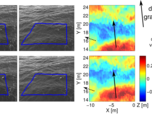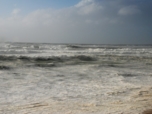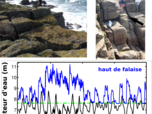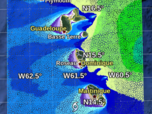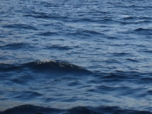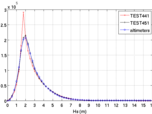Wave watching: short waves do not go in the wind direction
Using a novel stereo-video system we have observed that short waves go in much more oblique directions than previously thought ... at least for moderate winds and close to the coast
surf beats & Earth's hum
The solid Earth is ringing with incessant oscillations caused by ocean waves, that take the form of seismic waves. These "noises" range over 8 octaves, just like a piano keyboard, but with much lower and inaudible tones, with periods of 0.5 to 500 s. The faintest of these signals are found in the lowest tones, with periods 50 to 300 s, and amplitudes of a few tens of nanometers. These weak signals were only discovered in 1998. A team of French researchers has now established that the amplitude of the vertical component of these motions can be predicted from the known properties of ocean waves. Their paper just appeared in the Journal of Geophysical Research and provides a detailed quantitative theory for how much ocean waves, from very long ones to short ones across 6 octaves, interact with the ocean floor to produce seismic waves. This research opens the way to a better use of seismometer data from all around the globe, for the analysis of ocean storm properties and properties of the solid Earth.
Observations of large infragravity-wave run-up at Banneg Island, France
It is well known that waves are the source of increased sea level during storms, but how high can the water reach? This question has been studied in details for gently sloping beaches or coral reefs. New measurements for a steep cliff off the French west coast are providing clues to the formation of mysterious piles of rock at the same. The observed water motions could explain some anomalous high water levels reported on top of cliffs around the world. In the study to be published soon in Geophysical Research Letter, the measurements show that oscillations with periods of a few minutes, also known as 'surf beat' or 'infragravity waves' can add 3-meters to the water level, allowing waves to attack the top of the cliff and go over the top. This strong oscillation of the sea level is clearly driven by the normal waves, with an amplitude that increases with both wave height and period. The oscillations are also confined very close to the cliff itself.
waves on currents
Without currents, the life of waves would be simple: waves are borne from the wind and radiate away as swell when the wind dies until they eventually themselve die when breaking on the shoreline. With currents in the way things can be much more chaotic and result in very unusual sea states that are dreaded by mariners or leisure boaters: short choppy seas, very high waves in opposing currents... In theory this is fairly well known, but in practice it is hard to put all the pieces of the theoretical puzzle to understand waves over currents. When it gets complicated this is where a numerical model can be useful. This is what was just done in a study published in the Journal of Physical Oceanography (December 2012), summarizing the current effects as three distinct contributions: blocking, turning and bunching. New measurements off the French Atlantic coasts are particularly revealing of the last two effects ...
From oceans to lakes, hurricane Sandy reveals clear improvements in wave forecasts
As hurricane Sandy crashed onto the U.S. East coast on October 29, the Great Lakes saw some near-record high sea states, with wave heights up to 6.6 m in southern Lake Michigan. These were very well captured by the new wave modelling system developped in partnership between Ifremer and the U.S. weather service (NOAA/NCEP).
Seismic noise source verified
Seismic noise is increasingly used for monitoring the solid Earth (volcanoes, seismic faults) and storms at sea because we know that this noise is mostly generated by ocean waves. However, the detailed location of noise sources is still debated. A previous work established that numerical wave models could be used to estimate the magnitude and location of this noise. The study published these days in Geophysical Research Letters takes this one step further by showing that the loudest sources of noise are caused by the head-on collision of small swells in the middle of the ocean, which radiate seismic waves along the oceanic and continental crust, all the way to land stations. This interpretation is based on the analysis of noise polarization recorded all around the source, and the good fit between observed and modeled seismic data. These loud noise events should not be mistaken for extreme wave events when analyzing the noise record in terms of sea state. These events, recorded by many stations, may also provide a basis for estimating the attenuation of seismic waves and thus the properties of the Earth.
Des vagues à la stratosphère grace aux infrasons: la thèse de Marine De Carlo
Qu"il s'agisse de mieux détecter des explosions, de sonder les propriétés de la stratosphère ou de mesurer les vagues, il fallait d'abord mieux comprendre comment les vagues font des infrasons. C'est le défi relevé par Marine De Carlo. En direct à 16h le 15/12/2020 sur
https://youtu.be/ETxwSZFZsC0
IG wave workshop. March 12-13 2015
The workshop "From surf beats to the Earth's hum: understanding infragravity waves and interpreting long period signals" hosted on March 12 and 13 by LabexMer at IUEM (Brest, France), will gather researchers from around the world interested in coastal hydrodynamics, ocean engineering, and seismology... with a common interest in slow motions, with typical oscillation periods from 30 s to 5 minutes.
waves 2013 short course
This week of training dedicated to handling ocean wave data and numerical wave modelling will mark the end of the IOWAGA project, with many developments now mature and ready to be used by other researchers and engineers, providing a more accurate and comprehensive view on ocean waves and their role in the Earth system.
This training also coincides with the new release - version 4.12 - of the numerical wave prediction model WAVEWATCH III. These are the two main reason to host a "short course" under the aegis of Labex Mer, in Brest. We have accepted 25 eager candidates for a week of training dedicated to handling ocean wave data and numerical wave modelling. This short course will be repeated in March 2014, and will later alternate with a course organized by NCEP and the University of Maryland.
Record wave heights
February 2011 was extremely stormy in the North Atlantic. A study just published in the Bulletin of American Meteorological Society (December 2012 issue) looks into the anatomy of a record-breaking monster: extra-tropical storm Quirin was caught blowing ocean waves up to significant heights of 20.1 m on February 14 in the middle of the Atlantic...
Measuring ocean waves with seismometers
As you read these lines, the ground below you is moving up and down every few seconds by a few micrometers at most, due to waves in the ocean. This very small motion, a tenth of the width of a hair, and its relation to waves have been known for nearly a century. Its amplitude increases when storms are present in the nearest oceans. What is new, and just published in the Journal of Geophysical Research, is that we now know exactly under what conditions this "seismic noise" is made by waves, and where seismic stations on may be used to measure waves.
This result opens the way to a more quantitative use of old seismic records, which go much further back in time than wave measurements at sea, and the monitoring of waves in poorly instrumented regions of the world ocean, in particular the Southern Hemisphere.
swell dissipation
A threshold effect in the TEST441 parameterization of wave dissipation (Ardhuin et al. JPO 2010) has been corrected. The new parameterization, named TEST451, gives an average reduction of 4.2% in the error on the wave heights, and a much more realistic distribution of wave heights. This was done by smoothing the transition from a laminar to a turbulent atmospheric boundary layer. The change has been included in the Ifremer code repository (trunk, revision 513) and will be transferred shortly to NOAA/NCEP as part of the NOPP-supported project on the improvement of numerical wave models. The new parameterization should be used shortly by the Previmer system. Tests are under way to further optimize the results. This is the largest single improvement to the model parameterizations since the definition of the TEST350 parameterization, back in 2007.
All the IOWAGA and Previmer products that have a NetCDF attribute "software_version=4.05-Ifremer_revXXX", with XXX > 512, will include these changes.

